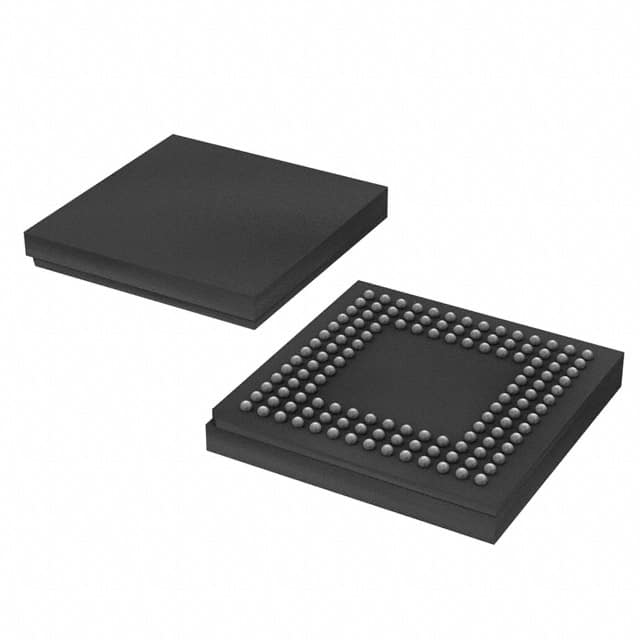Vedi le specifiche per i dettagli del prodotto.

XC2C128-6CP132C
Product Overview
Category
XC2C128-6CP132C belongs to the category of programmable logic devices (PLDs).
Use
This product is commonly used in digital circuit design and implementation. It provides a flexible and customizable solution for various applications.
Characteristics
- Programmable: XC2C128-6CP132C can be programmed to perform specific functions according to the user's requirements.
- High-density: It offers a large number of configurable logic blocks, allowing for complex designs.
- Low power consumption: The device is designed to operate efficiently with minimal power consumption.
- Fast operation: XC2C128-6CP132C provides high-speed performance, enabling rapid data processing.
Package
The XC2C128-6CP132C is available in a compact and durable package, ensuring its reliability and ease of integration into electronic systems.
Essence
The essence of XC2C128-6CP132C lies in its ability to provide a reconfigurable hardware platform that allows users to implement custom logic functions.
Packaging/Quantity
This product is typically packaged in trays or tubes, with each containing a specified quantity of XC2C128-6CP132C devices.
Specifications
- Device type: Programmable Logic Device (PLD)
- Family: XC2C
- Logic cells: 128
- Speed grade: -6
- Package type: CP132
- Operating temperature range: -40°C to +85°C
- Supply voltage: 3.3V
- I/O pins: 132
Detailed Pin Configuration
The XC2C128-6CP132C has a total of 132 I/O pins, which are arranged as follows:
- Pin 1: VCCIO
- Pin 2: GND
- Pin 3: IO0
- Pin 4: IO1
- ...
- Pin 131: IO130
- Pin 132: IO131
Functional Features
XC2C128-6CP132C offers the following functional features:
- Configurable logic blocks (CLBs) for implementing custom logic functions.
- Programmable interconnects to establish connections between CLBs.
- Dedicated input/output (I/O) pins for interfacing with external devices.
- On-chip memory elements for storing data.
Advantages and Disadvantages
Advantages
- Flexibility: XC2C128-6CP132C allows for easy modification of logic functions, enabling rapid prototyping and design iterations.
- High-density integration: The device offers a large number of logic cells, allowing for complex designs in a single chip.
- Low power consumption: XC2C128-6CP132C is designed to operate efficiently, minimizing power consumption.
Disadvantages
- Limited resources: The available logic cells and I/O pins may restrict the complexity and scale of designs.
- Programming complexity: Utilizing the full potential of XC2C128-6CP132C requires expertise in hardware description languages and programming tools.
Working Principles
XC2C128-6CP132C operates based on the principles of field-programmable gate arrays (FPGAs). It consists of configurable logic blocks (CLBs) interconnected through programmable interconnects. These CLBs can be programmed to implement desired logic functions, creating a customized digital circuit.
The device is programmed using hardware description languages (HDLs) such as VHDL or Verilog. The user defines the desired logic functions and interconnections, which are then synthesized into a configuration bitstream. This bitstream is loaded onto the XC2C128-6CP132C, configuring it to perform the specified functions.
Detailed Application Field Plans
XC2C128-6CP132C finds applications in various fields, including:
- Embedded Systems: It can be used to implement custom logic functions in microcontroller-based systems, enhancing their capabilities.
- Communication Systems: XC2C128-6CP132C enables the implementation of complex protocols and signal processing algorithms in communication devices.
- Industrial Automation: The device can be utilized for controlling and monitoring industrial processes, providing flexibility and adaptability.
- Automotive Electronics: XC2C128-6CP132C can be integrated into automotive systems for implementing advanced driver assistance features and control modules.
Detailed and Complete Alternative Models
Some alternative models to XC2C128-6CP132C include:
- XC2C256-7CPG132C: This model offers a higher logic cell count and operates at a faster speed grade.
- XC2C384-10PQG208C: With increased logic capacity and more I/O pins, this model is suitable for larger-scale designs.
- XC2C512-10FTG256C: This variant provides even higher logic density and additional features for demanding
10 domande e risposte comuni relative all'applicazione di XC2C128-6CP132C nelle soluzioni tecniche
Sure! Here are 10 common questions and answers related to the application of XC2C128-6CP132C in technical solutions:
Q: What is XC2C128-6CP132C? A: XC2C128-6CP132C is a field-programmable gate array (FPGA) manufactured by Xilinx. It offers 128 macrocells, operates at a speed grade of -6, and comes in a 132-pin chip package.
Q: What are the typical applications of XC2C128-6CP132C? A: XC2C128-6CP132C can be used in various applications such as digital signal processing, embedded systems, industrial automation, telecommunications, and high-performance computing.
Q: How does XC2C128-6CP132C differ from other FPGAs? A: XC2C128-6CP132C stands out with its specific features like the number of macrocells, speed grade, and pin count. These factors determine its capabilities and compatibility with different designs.
Q: Can XC2C128-6CP132C be programmed using VHDL or Verilog? A: Yes, XC2C128-6CP132C can be programmed using both VHDL (VHSIC Hardware Description Language) and Verilog (a hardware description language).
Q: What tools are required to program XC2C128-6CP132C? A: To program XC2C128-6CP132C, you will need a compatible development board, a programming cable, and software tools such as Xilinx ISE or Vivado Design Suite.
Q: What is the maximum operating frequency of XC2C128-6CP132C? A: The maximum operating frequency of XC2C128-6CP132C depends on the design and implementation. However, it is typically capable of operating at frequencies up to 100 MHz or higher.
Q: Can XC2C128-6CP132C be used in low-power applications? A: Yes, XC2C128-6CP132C offers power-saving features such as clock gating, power-down modes, and dynamic power management, making it suitable for low-power applications.
Q: Is XC2C128-6CP132C compatible with other Xilinx FPGAs? A: XC2C128-6CP132C belongs to the CoolRunner-II family of Xilinx FPGAs. It is compatible with other members of this family, but compatibility with other Xilinx FPGA families may vary.
Q: Can XC2C128-6CP132C interface with external devices? A: Yes, XC2C128-6CP132C supports various communication protocols such as SPI, I2C, UART, and GPIO, allowing it to interface with a wide range of external devices.
Q: Are there any development resources available for XC2C128-6CP132C? A: Yes, Xilinx provides comprehensive documentation, application notes, reference designs, and online communities where developers can find resources and support for working with XC2C128-6CP132C.
Please note that the answers provided here are general and may vary depending on specific requirements and use cases.

